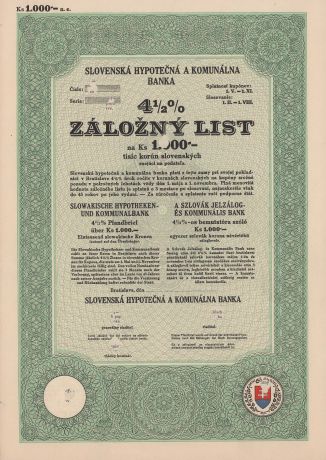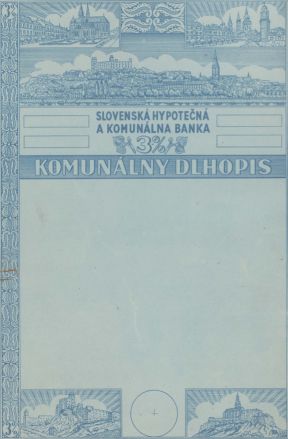The NBS Archives are open to the public at the following times:
Tuesday, Wednesday and Thursday
9 a.m. to 12 noon /
12:45 p.m. to 3 p.m.
In July, August and September the Archives are closed to the public.
The Archives will be closed to the public from December 16, 2025 to January 16, 2026.
Slovenská hypotečná a komunálna banka, Bratislava
Towards the end of 1938, after Slovakia was declared autonomous, the idea arose to establish a bank dealing with long-term debt issuance. The then Slovak government came up with an idea to make a new debt-issuing bank from the branches of Zemská banka and Hypotečná banka česká in Bratislava. Its working name was Krajská banka pre Slovensko (Regional Bank for Slovakia). The authorised representative of the government responsible for the matter was Anton Mederly, General Manager of Ľudová banka in Ružomberok, who was charged with preparatory works for the establishment of the new institution. After intense negotiations an agreement was reached between representatives of Zemská banka in Prague, Hypotečná banka česká in Prague and the newly established Slovenská hypotečná a komunálna banka (Slovak Mortgage and Municipal Bank) in Bratislava.
 Slovenská hypotečná a komunálna banka was formally established by Government Order No 77 of 24 April 1939 and started to operate on 1 July 1939. Consequently, the branches of Zemská banka and Hypotečná banka česká in Bratislava ceased their operation in Slovakia from 30 June 1939. Their debt-issue operations and trades in movable assets related to the territory of the then Slovak State were gradually taken over by Slovenská hypotečná a komunálna banka. The volume of Zemská banka’s securities-funded loans was so large, however, that Slovenská hypotečná a komunálna banka only completed their buy-out in 1940.
Slovenská hypotečná a komunálna banka was formally established by Government Order No 77 of 24 April 1939 and started to operate on 1 July 1939. Consequently, the branches of Zemská banka and Hypotečná banka česká in Bratislava ceased their operation in Slovakia from 30 June 1939. Their debt-issue operations and trades in movable assets related to the territory of the then Slovak State were gradually taken over by Slovenská hypotečná a komunálna banka. The volume of Zemská banka’s securities-funded loans was so large, however, that Slovenská hypotečná a komunálna banka only completed their buy-out in 1940.
The new bank was to grant long-term and irrevocable loans funded by issues of securities. Their long-term character and irrevocability would be based on funds earned from the sale of mortgage and municipal bonds issued after the loan was approved. At the beginning, the issued securities were difficult to allocate, although the situation improved later. The bank’s activities were extended by Act No 257 of 25 November 1941, which authorised it to co-regulate the government securities market and to participate in state credit transactions. Through its intervention activities the bank increased the value of government securities holdings, enabled marketability of the securities and regulated their free circulation. Yields on government securities were rising, which translated into the introduction of credit for economic restructuring. Based on Act No 22 of 11 February 1942, Czechoslovak government securities were exchanged for a Slovak conversion loan and tied government securities holdings were loosened. Statutory holdings of government securities were deposited in Slovenská hypotečná a komunálna banka. Act No 172 of 22 July 1941 entrusted the bank with providing cashier, accounting and administrative services to the newly established Pomocný fond peňažných ústavov (Assistance Fund of Financial Institutions), which collected contributions from financial institutions and paid out state assistance to cover losses that threatened a financial institution’s solvency.
Slovenská hypotečná a komunálna banka was originally composed of three departments. The Mortgage Department dealt with loans secured by real estate and with state guaranteed investment syndicated loans for companies. The Municipal Department administered municipal loans for the state, regions, districts and towns, loans to other public corporations, loans to soil amelioration and draining cooperatives, as well as loans for railway construction and electrification. The Banking Department took deposits, traded in securities, discounted bills of exchange, conducted giro and overdraft transactions, issued cheques and letters of credit, offered safe custody and asset administration services, provided state guaranteed syndicated loans for companies’ operation, assisted in setting-up and financing of companies co-managed by local government corporations, rented safe boxes, and bought and sold foreign exchange.
The bank was managed by a directorate chaired by general director. The first general director was Anton Mederly. The directorate also included three directors – Anton Haspel, Jozef Štetina and Mikuláš Franek, and seven other executive members. After Bratislava was liberated from the Nazis, the bank was put under temporary administration based on Decree No 701/45 of the Executive Authority for Finance of 14 April 1945. The bank’s temporary administrators were Elo Šándor, Matej Murtin and Juraj Jurkovič. When the temporary administration was lifted, a new, two-member, directorate was nominated, comprising Elo Šándor and Matej Murtin. Both managers already had experience in the field of mortgage banking, Šándor in Hypotečná banka česká and Murtin in Zemská banka. On 31 March 1948 the bank’s articles were changed, re-introducing the position of general director, to which Elo Šándor was appointed.
In 1945 the assets of Slovenská hypotečná a komunálna banka amounted to 2.7 billion Slovak crowns (Ks), deposits on passbooks totalled Ks 224.2 million and reserve funds equalled Ks 133.7 million.
 After the Second World War, the Slovak economy was depressed and required restructuring. Many businesses applied for loans to restore their operations. A syndicate of financial institutions was established (including e.g. Slovenská banka and Tatra banka) to facilitate this under the leadership of Slovenská hypotečná a komunálna banka. These loans were guaranteed up to the amount of one billion crowns by the Executive Authority for Finance (under its Decree No 8341/45-VI/19 of 17 November 1945). Syndicated loans were approved by a committee consisting of representatives of the Executive Authority for Finance, Executive Authority for Industry and Trade, Executive Authority for Nutrition and Supply, Executive Authority for Agriculture, Národná banka Československá - Regional Institute for Slovakia, the State Planning and Statistical Office, and representatives of the syndicate’s members and manager - Slovenská hypotečná a komunálna banka.
After the Second World War, the Slovak economy was depressed and required restructuring. Many businesses applied for loans to restore their operations. A syndicate of financial institutions was established (including e.g. Slovenská banka and Tatra banka) to facilitate this under the leadership of Slovenská hypotečná a komunálna banka. These loans were guaranteed up to the amount of one billion crowns by the Executive Authority for Finance (under its Decree No 8341/45-VI/19 of 17 November 1945). Syndicated loans were approved by a committee consisting of representatives of the Executive Authority for Finance, Executive Authority for Industry and Trade, Executive Authority for Nutrition and Supply, Executive Authority for Agriculture, Národná banka Československá - Regional Institute for Slovakia, the State Planning and Statistical Office, and representatives of the syndicate’s members and manager - Slovenská hypotečná a komunálna banka.
The political changes after the events of February 1948 resulted in the introduction of Act No 183 on Investičná banka, which was approved on 20 July 1948. The Act ordered that all rights and obligations of Slovenská hypotečná a komunálna banka and several other financial institutions would be transferred via universal succession without liquidation to the newly established Investičná banka, which started its operation on 1 October 1948. The new bank was centrally managed from Prague, while in Slovakia it was represented only by a regional office and several branches.
In 1958, the organisational units of Investičná banka in Slovakia and most of their activities were incorporated into Štátna banka československá. The operation of Investičná banka was limited to the completion of transactions and liquidation of claims of the financial institutions from which it had been established. In 1957, mortgage loans granted by these institutions were transferred to the Central Liquidator of Financial Institutions and Enterprises (whose legal successor became the Administration of Property and Foreign Exchange Affairs in 1964). Documentation on liquidated cases returned to the Office of Investičná banka in Bratislava, which was established in 1962 and processed certain documentation for the Central Liquidator. The Office was closed in 1969 and its activities were transferred to the Regional Institute for Slovakia of Štátna banka československá. The documentation was stored in the Bratislava Branch of Štátna banka československá, which was responsible for archiving services. Between 1958 and 1963, documents of Investičná banka were stored in Bratislava at 12 Leningradská Street (today Laurinská Street) and later, in 1963, transferred to 1 Nedbalova Street. Part of the documents were discarded and destroyed in the 1950s.
Eventually, the documents were deposited in a former monastery at Marianka, which served as archives for the Regional Institute for Slovakia of Štátna banka československá. From 1975 to 1977 they were moved to a new building of the Archives located at 27 Krajná Street in Bratislava and in 2003 to the premises of Národná banka Slovenska at 8 Cukrová Street.
The documents mainly include records and books of the bank’s headquarters and credit and deposit documentation. In 2014, an inventory of the first part of the fond was made, which reflects the original organisational structure of the bank. The archive fonds can be used for the research of mortgage banking and lending as well as investment history in Slovakia from the beginning of the Second World War until 1948.


